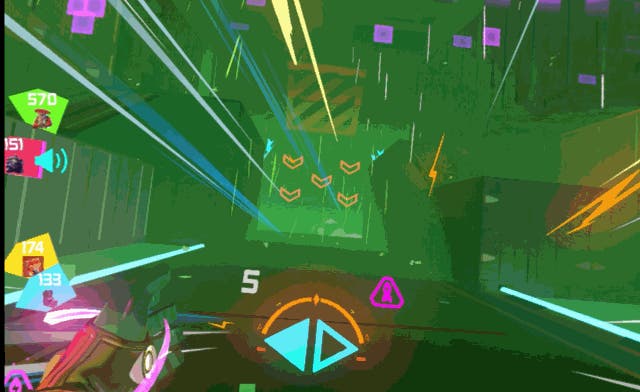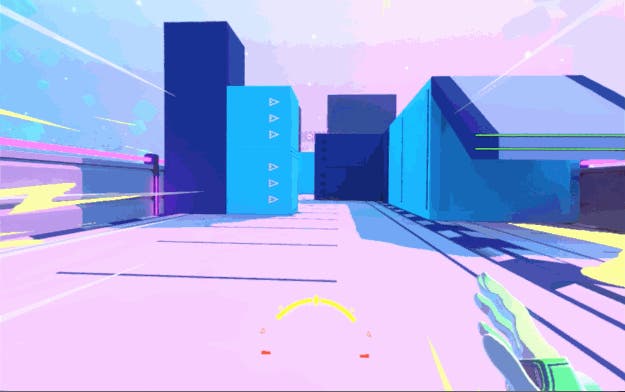Sprint Vector review - intensely physical VR racer
Skate or fly!
I'm going to kick this review off with a quick word of warning. Do not, whatever you do, play Sprint Vector right after an all you can eat carvery. Because I played Sprint Vector for the first time after an all you can eat carvery, and it made me feel wonky for the rest of the night.
That's why, before I even get into how the game works, it's well worth pointing out that Sprint Vector is one of the most intensely physical PSVR games I've played to date. If you're not a fan of titles that require you to stand up and get sweaty then it's safe to say this is not the game for you.
The same can also be said to those of you out there with limited VR playspace. Although the setup blurb suggests you can play the game seated, Sprint Vector relies on full upper-body movement in order to work properly. That's all well and good in theory but when I tried to play it in a seated position the controls were so unresponsive it made the game unplayable.
Fast-forward half an hour or so and, after moving around a bunch of furniture, I was finally able to create just enough space for the PSVR to track my arm movements correctly. Yes, it was a mission to get it all up and running but the results were well worth it. I walked away from my first session dizzied, out of breath and (thanks to a nearby, immovable shelving unit) sporting a couple of bruised knuckles. Despite all that I was incredibly keen to go back in and play it again; the adrenaline rush that Sprint Vector administered had left me thirsty for more.

Think of Sprint Vector like a cross between Mario Kart, Jet Set Radio Future and Mirror's Edge. It's an arcade racer, on rollerblades, where winning depends on finding the best routes possible in order to flow through your environment without losing speed. The setup is familiar video game fare; you're a contestant on a futuristic game show where success is success and failure - well, that's death. The VR twist here is that you must use your own bodily movements to propel yourself around multi-level, multi-route race tracks that are full of deadly traps, bottomless pits and aggressive, power-up wielding opponents.
To get yourself moving along said tracks takes more than a small amount of physical effort. To increase your speed you need to quickly swing your arms up and down, a bit like how speedskaters might move their arms if they were stood upright rather than hunched over. At the height of your swing you squeeze the trigger button on your Move controller and then you release it at the bottom; almost like you're grasping at an invisible rope in order to pull yourself forwards. Reaching maximum speeds isn't all about how fast you can pump your arms though - keeping a steady form and rhythm is the key to achieving top lap times.
If that sounds tiring you'd be right, but thankfully each race takes only around 2 to 3 minutes to complete. That's enough time to break a sweat after a couple of goes, but it'll never leave you feeling like you've over exerted yourself.
Once you've got your head around the basic concept of movement, things start getting infinitely more tricky. Sprint Vector has an incredibly steep learning curve and there's a lot to take in as you careen round the tracks; from chaining together double jumps and flying in order to cross large chasms, through to activating the many collectable power-ups. Learning how to drift turn correctly is one of the many advanced maneuvers you'll need to master. By holding down the brake button on the side you want to turn to and pumping with the other arm your character will take tight bends without the need for you to physically turn your body in real life.
The game comes with around 12 tracks for competitive racing, although most maps do tend to reuse or reverse sections from existing levels. The first track, Winter Rush, is relatively gentle but as you progress through the game, the layouts become much more complex. Later races introduce a lot of verticality that will stop you dead in your tracks unless you've mastered how to climb walls correctly. By jumping at a wall and pulling the trigger on your controller at the right time you'll grab onto a green handhold. Then by raising your hand above your head and pulling it down rapidly while releasing the trigger you'll catapult yourself upwards. I found that movement in particular to be quite awkward to pull off correctly, the game would often fire me backwards away from the wall necessitating a frustrating reclimb. During the times when it did work, throwing myself up tall walls at speed was a great sensation; I felt like a super-powered Agent scaling skyscrapers in Crackdown.

Keeping a forward momentum is imperative if you want to win medals in Sprint Vector and there are plenty of boosts pads and nitro power-ups dotted around to help you do this. Conversely, there are so many hazards littering the tracks that crashing into objects and coming to an abrupt, jarring halt is only a matter of time. This is especially true in the early hours of the game when you are still feeling your way around each track.
Surprisingly, with all this extreme movement going on, Sprint Vector really nails the comfort factor when it comes to reducing nausea in VR. Falling down a big hole or launching yourself into a particularly powerful jump are things that will occasionally turn your stomach, but it's never that extreme. By using actual, physical movements to control your character, it grounds you in the world and it means you're less likely to experience that out-of-body jolt that can cause tummies to turn.
During solo play your fellow competitors, a colourful bunch of aliens, humanoids and holograms, will be controlled by AI. Whilst these opponents offer a slight challenge to anyone familiar with the tracks, if you continually fail a section of a race they will often stop and wait for you to catch up. That's ever so nice of them, but it looks and feels a bit odd, especially when they decide to race back along the track to see how you're doing.

For an actual test of your skill you'll need to go for online multiplayer and race real life people. I had a few problems finding opponents in the EU server but on the US side there were plenty of people to race with. Most of them had live mics but instead of being toxic, anyone who spoke was friendly and happy to offer help to newcomers, giving the lobbies a welcoming atmosphere.
If you fancy taking some time out from all that competitive racing, there are a number of exclusive challenge maps on offer that'll test your speed and ability to navigate the environment. Whether it be a time trial or an item collection run, nailing those top speeds and perfecting those routes can be quite addictive. In my mind these challenges felt very much like playing a VR version of Mirror's Edge.

While most of my races, competitive or otherwise, went off without a hitch, I did have the occasional calibration issue. These could have been down to my tiny play area, or my own unwieldy movements but either way, every so often I'd boost wildly and unexpectedly to the left or right when trying to run forwards. More often than not this would put me at the bottom of a pit, forcing an aggravating restart at the nearest checkpoint.
With all this in mind my recommendation comes with a few caveats. If you're a VR enthusiast with a decent sized games room and a good stomach for intense action then you're in for a treat. If however you're a VR beginner, or someone with a cramped gaming area, you do run the risk of feeling like you've wasted your money.
Don't expect to just pick up this game and ace it straight away either. Getting to a point where you're actually good enough to sprint around a course without crashing every 30 seconds or so will take a lot of practice and perseverance. The learning curve really is punishing and it's imperative that you play through the four lengthy tutorials if you want to stand any chance of winning a race. Once that unique method of locomotion finally clicks though, the amazing feeling of physically powering your way through each level just cannot be matched by any VR game on the market.










